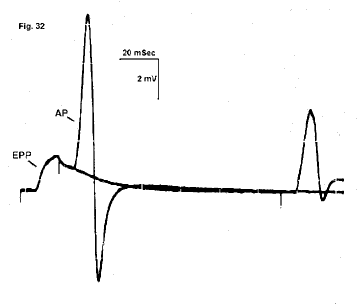In frog skeletal muscle, each motor nerve fiber entering a skeletal muscle branches several times, and each branch terminates as a discrete structure, the end plate, on a muscle fiber. There may be hundreds of such motor units (neuron plus its muscle fibers) in a muscle. The currents associated with a nerve impulse dying in a nerve terminal pass through the membrane of the postsynaptic cell. At some synapses in the nervous systems of some animals, these currents can depolarize the postsynaptic cell to the threshold level required to yield a propagated impulse. In vertebrate skeletal muscle, the depolarization is accomplished mainly by a chemical synaptic transmitter, acetylcholine (Ach), which is ejected from the nerve terminal membrane. Ordinarily, the local depolarization (the end-plate potential, or EPP) is immediately overwhelmed by a propagated action potential (AP) in the post-synaptic cell.
Under ordinary circumstances, a single EPP in a frog muscle will be followed by an AP. When the Mg++ in solution is several times normal concentration, as in the "diluted sea water Ringer" used in these exercises, or when a poison like curare is present, a single impulse entering the nerve terminal may provoke only an EPP and no AP.
